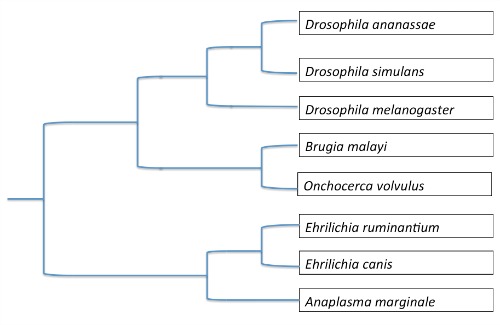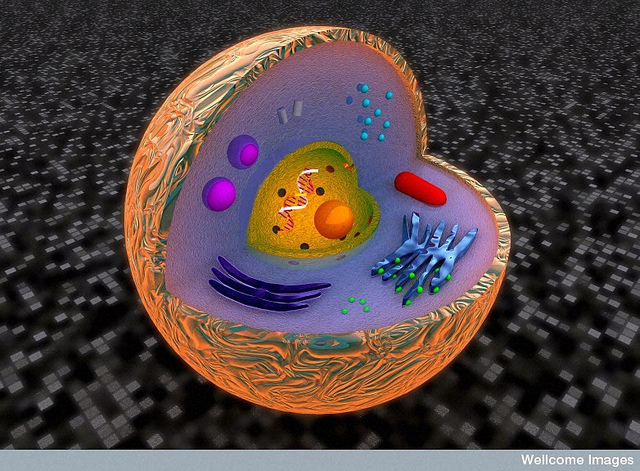Classification

Domain - Eukarya
Kingdom - Animalia
Phylum - Nematoda
Class - Secernentea
Order - Spirurida
Superfamily- Filarioidea
Family - Onchocercidae/Filariidae
Genus - Onchocerca
Species - Onchocerca volvulus (Myers
2014).
Figure 1. This phylogentic tree shows that the
bacteria
Wolbachia shares an
endosymbiotic relationship with
these given species. Information modified from Fenn, K. et al. 2006.
What is the reasoning for these classifications? We're glad you asked!
 Domain: The domain Eukarya contains
eukaryotic cells and the
majority of organism we encounter everyday. They can be unicellular
or multicellular and engage in cell division by mitosis, with many
different types of reproduction cycles. This domain originated 1.7
billion years ago from the first prokaryotic organisms (Sidwell
2014).
Domain: The domain Eukarya contains
eukaryotic cells and the
majority of organism we encounter everyday. They can be unicellular
or multicellular and engage in cell division by mitosis, with many
different types of reproduction cycles. This domain originated 1.7
billion years ago from the first prokaryotic organisms (Sidwell
2014).
Kingdom: This parasite is classified as an Animalia because it is multicellular and heterotrophic. Another reason is because this parasite ingests and digests food in an internal cavity. It lacks a cell wall like all other animals and also reproduces sexually by egg and sperm. There are an estimated 9 to 10 million species of animals inhabiting Earth, and Onchocerca volvulus is only one of those millions of species.
 Phylum:
The phylum Nematoda has characteristics of being surrounded by a
thick non-cellular layer known as a cuticle. Their cuticle is made
up of several layers of epidermal cells that run only
longitudinally. This parasite is classified as a Nematode because of
its simple nervous system consisting of dorsal and
ventral nerve cords running throughout the body (Myers 2014).
Phylum:
The phylum Nematoda has characteristics of being surrounded by a
thick non-cellular layer known as a cuticle. Their cuticle is made
up of several layers of epidermal cells that run only
longitudinally. This parasite is classified as a Nematode because of
its simple nervous system consisting of dorsal and
ventral nerve cords running throughout the body (Myers 2014).
Class: This parasite is classified into the class Secernentea because it has a primary excretory system which removes waste and unnecessary materials from the body of the organism. This helps the organism maintain homeostasis and helps prevent damage caused to the body. This system includes intercellular canals joined in front of and behind the excretory sinus (The Free Dictionary 2014).
Order: This classification in the order Spirurida makes the parasite have a mouth with tooth-like extensions on each side instead of having lips. The esophagus of this parasite is undersized and split into two parts. One of these parts is in the front section and is very muscular while the other part is expanded and in the rear of the esophagus. This classification also determines the host for this parasite, requiring an indirect and definitive host (Buller 2009).
Superfamily: The parasite is in the Filarioidea superfamily, which is made up of parasites that invade tissues in body cavities of mammals. These threadlike worms make their way to the tissues, the females leave their embryonated eggs, also known as microfilariae, where they are then taken into the body of blood- sucking insects. Then they are introduced to a human host where they then take around a year to mature (Encyclopedia Britannica 2014).
Family: This family of Onchocercidae includes slim, thread-like parasitic nematode worms living in vertebrates’ blood and tissues. This also classifies the parasite as being spread as larvae by biting insects. This family also contains around 70-80 genera (Fine Dictionary 2014).
 Genus: Onchocerca is a parasitic genus made of thread- like
roundworms that take over the connective tissues of their hosts and
become intertwined within firm nodules (Dictionary.com). Onchocerca
is most commonly found in tropical and subtropical parts of the
world (Junquera 2013).
Genus: Onchocerca is a parasitic genus made of thread- like
roundworms that take over the connective tissues of their hosts and
become intertwined within firm nodules (Dictionary.com). Onchocerca
is most commonly found in tropical and subtropical parts of the
world (Junquera 2013).
Species: Onchocerca volvulus is a nematode species that is
responsible for parasitic diseases in humans that are spread by
blood-feeding black flies. This disease is known as onchocerciasis,
or river blindness which is most commonly found in places such as
Africa, Latin America, and the Middle East (Encyclopedia of Life
2014).
A parasite that is very closely related, a
sister taxa even, to
Onchocerca volvulus is
Loa loa. This parasite is most like Onchocerca volvulus
because it is also transferred by the bite of a fly, to a human,
while the larvae then enters the host.

Figure 2. This phylogenetic tree shows the relationship among species within the order of Ascaridia, where Onchocerca volvuvlus fit in. Information modified from Xie, Y. et al. 2013.
What is the actual meaning of these words of the scientific name: Onchocerca volvulus?
Onchocerca is broken up into two different parts. The prefix of
oncho- is defined as a 'tumor' in the Greek language. The suffix
-cerca is translated to cercaria, meaning 'tail creatured' in the
Latin language.
The word volvulus is defined as meaning 'to twist' in Latin, which is referring to the Nematode movemvent. (The Free Dictionary 2014).
Continue to the Habitat Page to learn where this parasite lives!